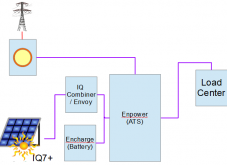Tom Pounds
New Member
- Joined
- Feb 17, 2021
- Messages
- 2
I may be a newbie to this forum, but I am familiar with wiring, power systems, solar systems, etc. being an electrical engineer with additional practical experience of doing many household electrical additions that didn't require the use of a licensed electrician (, but I also know my limits, the building codes, and when I would need to hire an electrician).
I want to bounce this idea off of this group.
My idea is to install another circuit breaker panel next to the existing 200A 36-breaker panel in the house (it is a big house). It would be installed flush mount in the wall one stud next to the existing panel (I'd need to check on code for that to see if that spacing is allowed). The two panels should be close, though, because I would need access to the existing romex wires in the existing main panel. I would choose certain critical circuits from the main panel, disconnect them from their breakers and even pull a pair of those breakers (explained later). The critical circuits would include outlets with refrigerators, freezers, heating and cooling units, microwave oven, strategic lighting around the house, etc. The total load for just these critical circuits would have to be limited to, perhaps, 60 or 70 A. By pulling the romex from the main panel, there should be enough length to re-route them to the adjacent new panel, each circuit with their own new circuit breaker as they were in the old main panel. A pair of breakers would be taken from the main panel (now that I have lots of empty breaker space) and replaced with a 60 or 70A double breaker (240V/120V) that would feed the AC input of a properly sized hybrid inverter. The 240VAC output of the hybrid inverter would then feed the new panel main breaker (60 or 70 A) which would feed the critical circuits. Several 1000 W of solar panels would also be connected to the hybrid inverter, as well as a multi-kWhr battery bank (voltages depending on the inverter requirements, etc.)
The hybrid inverter would be located physically close to the breaker panels, and the inverter would "choose" the best source of power at any given time; solar, battery, or grid, and keep the critical stuff alive all the time.
The wiring could be all done by me, safely, because I would be working on the house side of my main 200A breaker. I would only need to pull a permit and get the inspection.
This would never tie my solar system or batteries into the grid, so my meter would never run "backward".
Thoughts and comments?
TIA
I want to bounce this idea off of this group.
My idea is to install another circuit breaker panel next to the existing 200A 36-breaker panel in the house (it is a big house). It would be installed flush mount in the wall one stud next to the existing panel (I'd need to check on code for that to see if that spacing is allowed). The two panels should be close, though, because I would need access to the existing romex wires in the existing main panel. I would choose certain critical circuits from the main panel, disconnect them from their breakers and even pull a pair of those breakers (explained later). The critical circuits would include outlets with refrigerators, freezers, heating and cooling units, microwave oven, strategic lighting around the house, etc. The total load for just these critical circuits would have to be limited to, perhaps, 60 or 70 A. By pulling the romex from the main panel, there should be enough length to re-route them to the adjacent new panel, each circuit with their own new circuit breaker as they were in the old main panel. A pair of breakers would be taken from the main panel (now that I have lots of empty breaker space) and replaced with a 60 or 70A double breaker (240V/120V) that would feed the AC input of a properly sized hybrid inverter. The 240VAC output of the hybrid inverter would then feed the new panel main breaker (60 or 70 A) which would feed the critical circuits. Several 1000 W of solar panels would also be connected to the hybrid inverter, as well as a multi-kWhr battery bank (voltages depending on the inverter requirements, etc.)
The hybrid inverter would be located physically close to the breaker panels, and the inverter would "choose" the best source of power at any given time; solar, battery, or grid, and keep the critical stuff alive all the time.
The wiring could be all done by me, safely, because I would be working on the house side of my main 200A breaker. I would only need to pull a permit and get the inspection.
This would never tie my solar system or batteries into the grid, so my meter would never run "backward".
Thoughts and comments?
TIA



